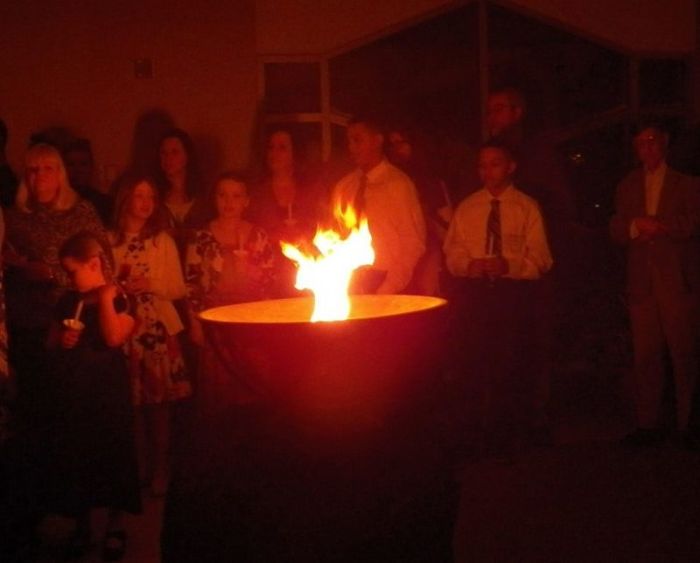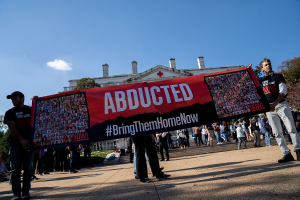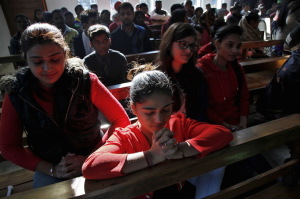A Holy Spirit awakening

In 1967, a group of students from Duquesne University, as well as a few students from neighboring universities, gathered to pray, armed with two resources: the Book of Acts from the Holy Bible and The Cross and the Switchblade by David Wilkerson.
The ways in which God showed up to this meager yet hungry group, evidenced by personal God-encounters and prayers in an unknown language, at a small retreat center called The Ark and the Dove in Gibsonia, Pennsylvania, birthed a Holy Spirit awakening within the Catholic Church.
The Holy Spirit outpouring at Duquesne quickly spread to campuses of other Catholic universities, particularly the University of Notre Dame, where students began to have their own experiences with the Holy Spirit. These encounters were evidenced by a renewed vitality in prayer, the gift of tongues and other charisms (gifts given by the power of the Holy Spirit), and expressions of deep, heartfelt worship.
“In the early days, we were known as ‘Catholic Pentecostals,’” explains Walter Matthews, executive director of the National Service Committee for the Catholic Charismatic Renewal in Locust Grove, Virginia. “Later, Cardinal Suenens from Belgium, who had surreptitiously visited the Renewal in the United States, suggested a name change so as to better fit into Catholic understanding. Thus, we became known as the Catholic Charismatic Renewal.”
As the Renewal spread nationally, South Bend, Indiana, and Ann Arbor, Michigan, became two key centers, as early leaders who emerged subsequent to the Pittsburgh experience were based primarily in these two cities. Internationally, Notre Dame played a significant role because at the time, the famed university served as a place where missionaries from other countries would come for refreshment. As Matthews explains, “A number of these missionaries encountered Renewal groups, were baptized in the Holy Spirit, and returned to their countries, causing the Renewal to spread quickly outside of the United States.”
To foster this new awareness and way of life within the Catholic faith, two primary outlets emerged (which are still in existence today): prayer groups and covenant communities. Prayer groups were created to meet once a week in church halls, basements, classrooms, and school buildings for the purpose of prayer, studying Scripture, worship, and to exercise the gifts of the Spirit. Covenant communities were formed as a way to emphasize more intentionality in relationships and the daily joining of lives with other believers, using the early church as a model.
Similar to past revivals and awakenings in church history, the Renewal has encountered its fair share of issues, such as learning how to engage and mentor younger generations.
“Even the Renewal needs a renewal; otherwise, we ourselves can get ossified,” says Dr. Mary Healy, professor of Scripture at Sacred Heart Major Seminary in Detroit, international speaker, and author. “Still,” she continues, “it’s very exciting to see what God is doing with a new generation that has contact with the Renewal and a passion for reaching the lost, who understand that we cannot do that without the power of the Holy Spirit.”
As for what Dr. Healy currently sees God doing within the Renewal, she focuses on three areas: a new impetus for unity within the Body of Christ, divine healing, and a great awakening to our identity and authority in Christ.
“I really believe that building bridges needs to be initiated by Catholics. We need to take the initiative and be humble enough to learn from our brothers and sisters. To the degree we do that, our Protestant brothers and sisters will be willing to learn from us.” She says that when followers of Christ gather as one, there is a unique anointing that comes, a special power from on high. “When we repent of the ways we look down on one another, it so pleases the Lord,” noting that “that which unites us is greater than that which divides us.”
Dr. Healy has a passion to see all members of the Body equipped as “ordinary healers,” a call that first arrested her on a mission to Brazil with renowned evangelist and Global Awakening founder Randy Clark. She regularly teaches on the connection between evangelism and signs and wonders, helping every Catholic realize that the power of the Holy Spirit who lives inside them is not limited to a select few.
While Dr. Healy sees the Lord awakening baptized believers to their glorious identity and authority in Christ, she also observes that many in the Catholic church are currently operating at a lower level than was shown in the New Testament. She states, “We need a renewal of the mind for what God desires. That’s what I try to do in my ministry.”
As the National Service Committee of the Catholic Charismatic Renewal enters a “new season” of commissioning (inspired by the Vatican’s formation of CHARIS), Ron Riggins, chairman of the NSC, projects a deepened vision and mission to: Bring the baptism in the Holy Spirit to the Church; Build unity in the body of Christ; and Serve the poor, both corporally and spiritually.
Riggins states, “The Holy Spirit did not come down upon the Apostles simply so that they could rejoice in having received this current of grace. ... But the Holy Spirit equipped the Apostles to become missionary disciples equipped with charisms to evangelize with the Good News and fulfill the Great Commission.”
Though distinct theological differences separate Catholics from protestants and evangelicals, there is most assuredly a strong common denominator: the same Holy Spirit. May we see each other through the same lenses of love, forgiveness, gifts, mission, power, and grace that we ourselves have been offered. And may we, together, do good, glorifying Jesus as we go through brotherly love and the power of the Holy Spirit.
If you would like more information about the Catholic Charismatic Renewal or to find a Renewal Center or prayer group in your area, please visit https://www.nsc-chariscenter.org or email chariscenter@nsc-chariscenter.org.
Stacey March lives in Culpeper, Virginia, with her husband and three children. She holds a Master of Human Services Counseling & Executive Leadership from Liberty University and a Master of Music from Stephen F. Austin State University in Nacogdoches, Texas. Connect with Stacey on Facebook and Instagram @stacey_march3




























